Optoma UHD51A
Product Name: Optoma UHD51A
Product Description: 4K DLP Projector
-
Design - 9/10
9/10
-
Video Quality - 9.2/10
9.2/10
-
Inputs / Ports - 9.5/10
9.5/10
-
OS, Apps and Features - 9.1/10
9.1/10
-
Price / Quality - 9.4/10
9.4/10
Summary
Total Score
Pros
- Very good overall 4K image with HDR
- Many connections
- A lot of features
- Competitive price
Cons
- Mediocre black levels
- Brightness lower than what was claimed
- High input lag
- No backlight remote
Cheapest Places to Buy :
*We are a reader-supported website. When you buy through links on our site, we may earn a small affiliate commission at no extra cost to you. Home Media Entertainment does not accept money for reviews.*
With the new 4K projectors that feature pixel shifting technology manufacturers seem to have managed to lower the prices enough in order to offer image quality closer than ever to what native 4K projectors offer with only 1/4th of the price you would pay for a true 4K model and as a result we see new models coming out this years that will try to get a portion of the mainstream market. But although image quality has improved and prices have gone down one area that projectors were still lagging behind TVs were in their smart capabilities.
This is where Optoma comes in offering us a new 4K UHD projector that features the familiar by now quad pixel shifting technology (1920 x 1080 x 4) but in addition to all it’s image and motion improving features, it is also equipped with smart technology and Alexa integration making it one of the first projectors to feature such specifications. But a projector is the sum of all it’s parts and Optoma made sure to also include features like HDR support, Wide Color Gamut (WCG), 3D support and Motion Interpolation in order to offer a complete feature rich model. So lets start our Optoma UHD51A review to find out what this projector holds for us and how good it really is.
Design
Design wise the Optoma UHD51A will not win any awards as it uses a relatively cheap plastic cover but what looses in build quality it gains in aesthetics as it uses a black colored chassis that combines glossy and textured surfaces. In order to add a bit of flavor in a relatively boring design Optoma added a silver strip in the middle that travels from one side of the projector, runs all around the lens and finishes on the other side which is a nice design touch. The projector is also offered in white color with a gold colored stripe which also looks very nice in our opinion.
Heat dissipation is also well thought with ventilation holes being plenty in both sides covering a pretty big part of the side covering and helping the internal fan to throw out the hot air without much trouble. And since we mentioned the fan we found it pretty quiet and in line with what Optoma states of giving it a noise rate of 28db or 25db in Eco mode making it very quiet during viewing.
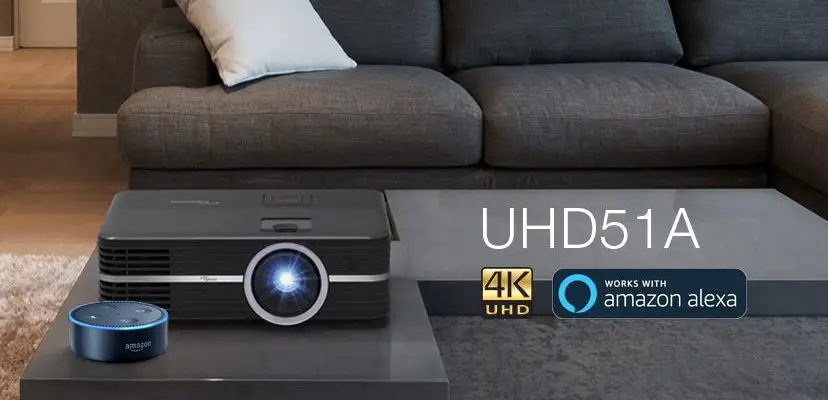
With a size of 15.4” x 11.1” x 5.1” (392 mm x 281 mm x 118 mm) and 11.75 lbs (5.22kg) of weight the UHD51A is relatively easy to carry around especially compared to some other 4K projectors that have monstrous sizes in comparison but is a bit bigger that other 4K pixel shifting projectors of the same category. This also makes mounting a bit easier as well as placing it in a smaller than usual media room. The lens are placed a bit to the left when looking it from the back and in order to manually adjust the focus you turn the lens barrel in the front.
Optoma has equipped the UHD51A with a 1.3:1 zoom which offers a bit more flexibility compared to some other competitors that have only 1.2:1 zoom capabilities and a vertical shift of 15% which most other competing models at the same price range don’t offer at all. Without vertical shift the bottom of the image falls exactly at the lens center. Offering 15% vertical shift you can move the image 15% above this axis meaning a bit more freedom when calibrating your image to the screen. Both zoom and vertical shift can be calibrated using the two control knobs on the top of the lens.

On top we also find some control buttons in a rectangular shaped design including menu navigation buttons as well as power, lamp values and temperature values among other. On the front right next to the lens we find a relatively large IR receiver while all the connections and ports are naturally located at the back and we will talk about these a bit further down our review. Last but not least there are three screw adjustable feet, one front and two rear, making level calibration easy and fast for those that are not ceiling mounting the projector.
Under the hood the UHD51A is equipped with the 0.47″ DLP chip from Texas Instruments making this projector a quad pixel shifting model. What this means is that the native resolution is 1920 x 1080 pixels but by moving them and fire each pixel four times we get the needed 8.3 million pixels required to classify it as a 4K projector.
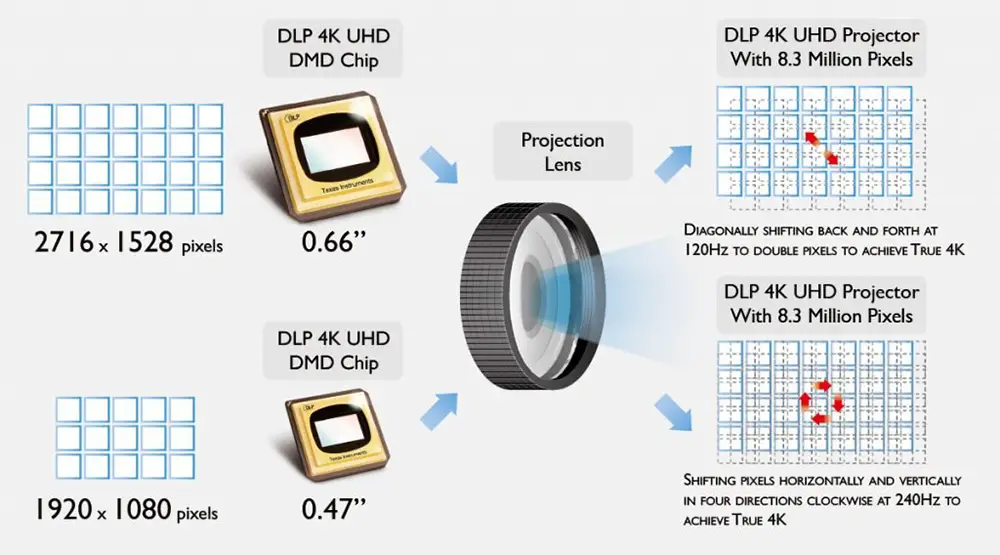
In order to avoid confusion there are two DLP chips with pixel shifting technology. The one we have here with 1,920 x 1,080 resolution and quad pixel shifting and another with 2,716×1,528 resolution and dual pixel shifting. The later is being used for example in the BenQ HT8050 that we reviewed recently but it also carries a much higher price tag. By using the 0.47″ chip Optoma managed to lower the price enough to make it one of the most affordable 4K projectors in the market while keeping the image quality at a certain level that is characteristic of these new DLP chips.
Lamp life is rated at 4,000 hours in Bright mode which is very good compared to some other models and 10,000 in Eco mode. There is a 15,000 hours Dynamic mode but this assumes that you leave the projector always on and drops the lamp power to very low levels so it cannot be taken as a comparison number. In total working hours are very good and since we are talking about a price sensitive model, consumers definitely will want to take this into consideration also.
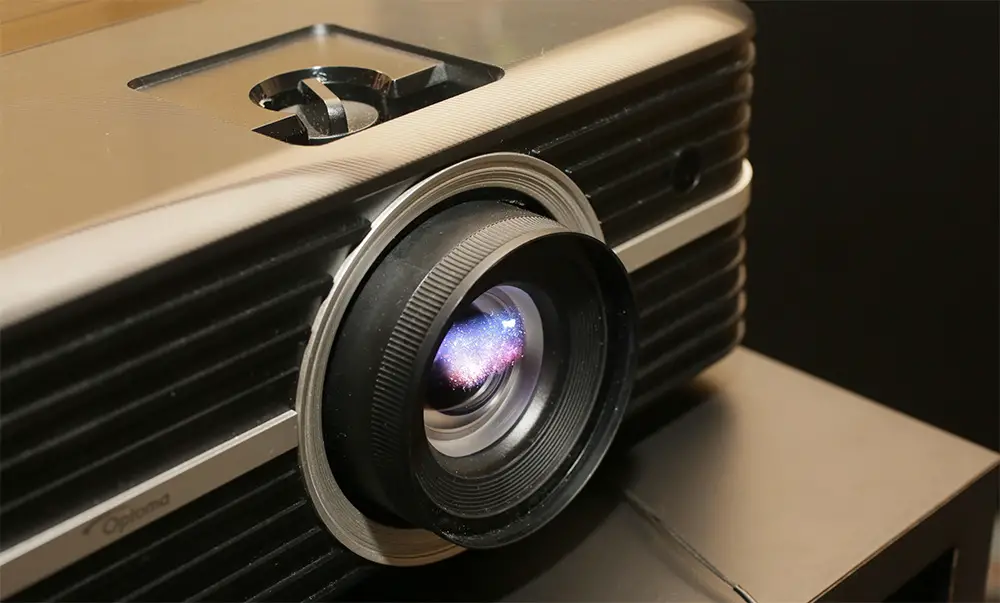
Included in the projector are two 5 Watts speakers so this increases the projector’s mobility usage as well as it’s usefulness in situations where there is no dedicated audio system. Of course the built-in speakers are not anything to brag about but in cases of need they will do the work adequately.
The included remote has a strange looking design, at least compared to other projector remotes we have tested in the past. At first look it will remind you some kind of Apple TV remote with its few buttons and minimalism design. The one that comes with the UHD51A has very smooth curves and round buttons with only symbols revealing the function of each button. Although for some this may be nice for others may be a bit hard to memorize the symbols and would prefer a short word to show each button’s functionality. In addition there is no backlight function which is a minus and can be a bit hard to use it in dark environments.

Video Quality
Being a 4K projector naturally we first tried a few 4K test scenes. As usual we tried our 4K UHD disc of Pacific Rim: Uprising and the first thing that impressed us was how clear and sharp the image was. The quality we saw is starting to become familiar for all projectors that use the same DLP chip from Texas Instruments. Of course there are minor differences as the final result does not depend completely on the chip itself but the picture show a certain level of clarity and detail that we have seen in some other models in this category.
Details like scratches on the metal armor of the Jaegers or imperfections on the actor’s skin are some examples of how many details are revealed by such a clear picture. During the Jager duel in the snow the image had an almost three dimensional feel while during the final battle in the city it felt like you were really there.
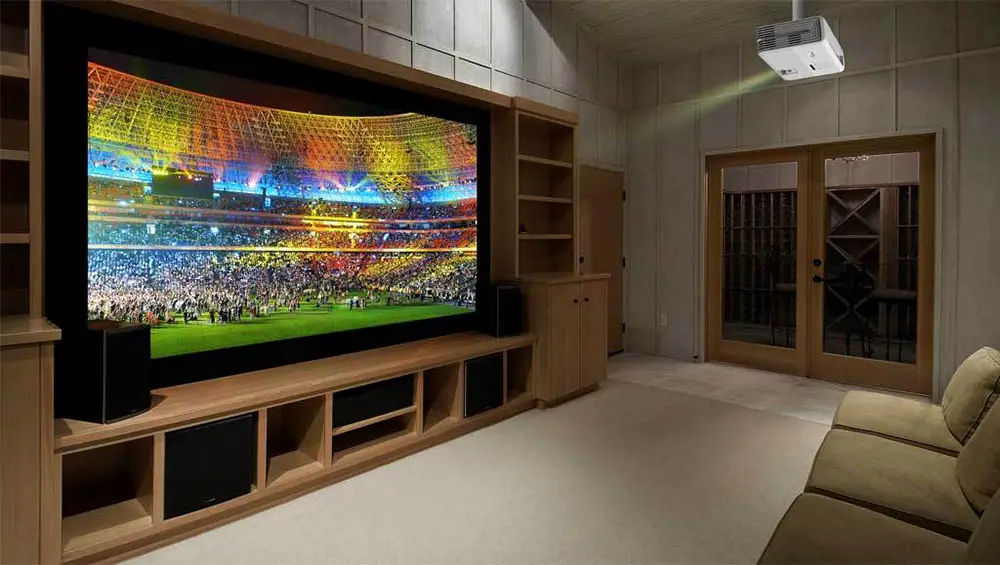
The projector also supports HDR and there are four supporting modes with all four giving very good results. These settings are Bright, Standard, Film and Detail and what the difference between them is that the image becomes darker or lighter affecting the shadows detail separation. UHD51A supports the standard HDR10 protocol but not HLG which is an HDR protocol for streaming content. Very good overall HDR performance helps the resulting image with great looking highlights giving the picture more depth.
The UHD51A supports wide color gamut with Optoma claiming 100% coverage of the REC.709 color space but also support for the DCI-P3 and Rec.2020 color spaces meaning more lifelike colors and true to what the director intended. The overall result may not be the most accurate there is but there is a very noticeable difference between SDR and HDR color and it’s one many users will appreciate.
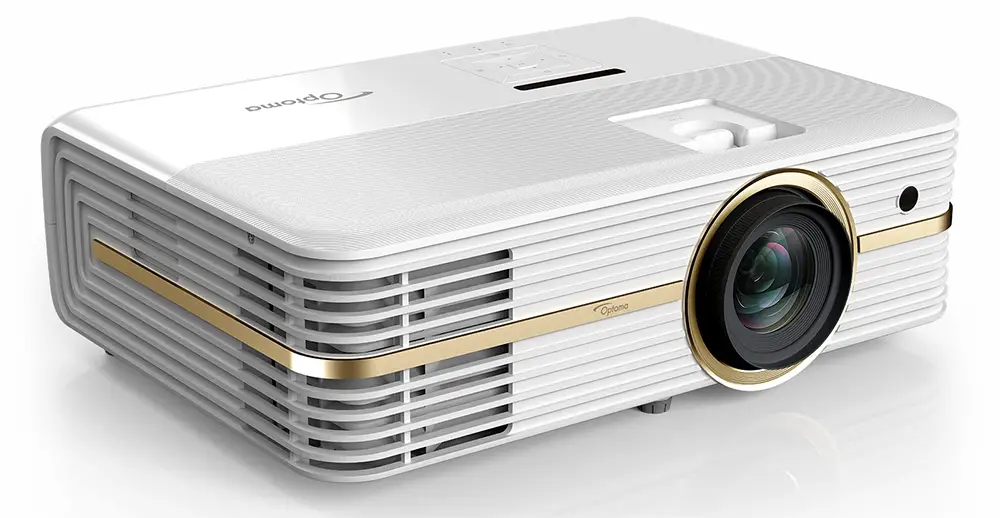
Optoma rates the UHD51A at 2,400 lumens but it seems in reality this number is much lower that what we expected it to be. There are five picture modes with them being Bright, Cinema, HDR, HDR Slim, Game and Reference. There is also a user mode for personal calibration. The mode that gave us the most brightness was Bright mode that reached almost 1,700 lumens but in our opinion it shouldn’t be used much as the picture tends to have a slight greenish tint which we didn’t like at all.
Reference mode output the least brightness at around 750 lumens but it is more accurate and should be used for non 4K/HDR content. As for 4K with HDR we would recommend either the HDR mode that outputs about 1,300 lumens or Cinema mode at about 1,100 lumens and both give a more or less accurate color representation. And with a bit of calibration they can produce even better results with minor changes to the brightness output.
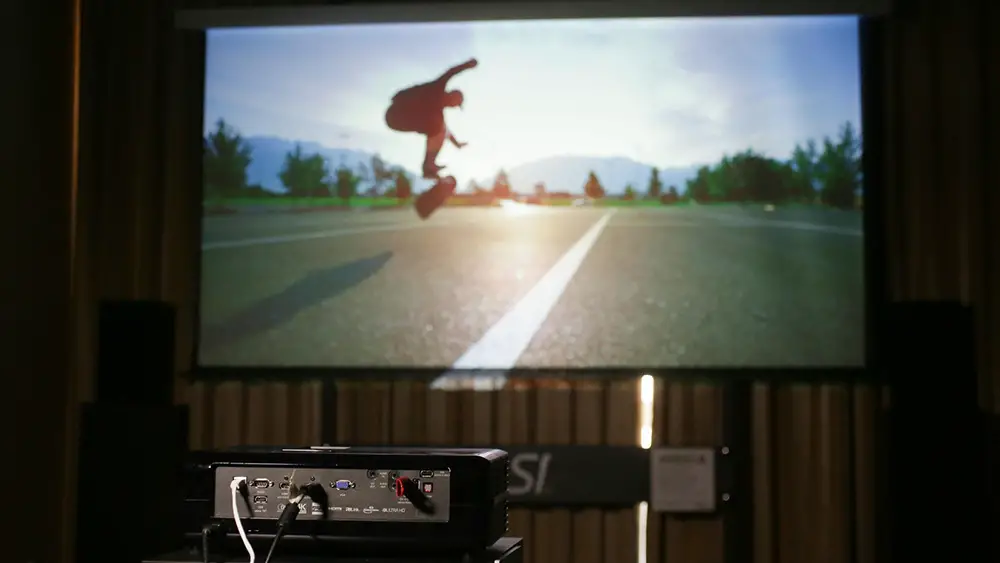
Let’s talk a bit about black levels now. In general if you see the projector for the first time and you don’t have a big experience in general with projectors you will find that the black levels of the UHD51A are pretty good and at acceptable levels for most. Projectors in this price range always have problems with black levels with very few exceptions so the performance we get here was to be expected. Only more experienced users or when it is compared to some more expensive models that can produce deeper blacks the difference becomes obvious.
Also very important is the kind of environment you will be most using it at. In a completely dark environment blacks will shows as deep greys but if your room will be more lit the result will be better and the blacks will show better. Optoma has also equipped the projector with a feature called Dynamic Black which uses lamp dimming to overall darken the image when there are no significant really bright areas. It helps a little but nowhere near as if there was a really good dynamic iris.
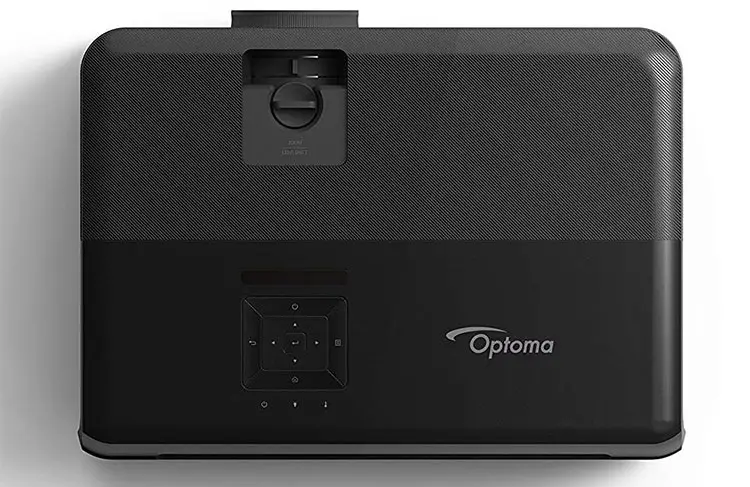
As good as the 4K with HDR performance is the projector is also very capable when displaying 1080p and SDR content. The image was clear with no visible artifacts while image noise was at levels we are used to see in this category. Very good overall here. The projector also has the ability to auto switch between SDR and HDR something very practical in our opinion. The projector will go black a few seconds while doing the switch but its far better than having to do it manually.
3D may be a dying format for home use but there are still many that have huge libraries with 3D movies and still support it so it is good to see the UHD51A have full 3D support for 1080p content. We have tried a couple of movies in 3D and we didn’t see any crosstalk or 3D related artifacts. Naturally brightness took a dive as always when watching 3D content but the end result was very pleasing with a clean and immersive result.

Motion performance was generally on par with other projectors in this range but the UHD51A has a feature that some projectors have while others don’t. And this is CFI, or Creative Frame Interpolation if you prefer, where the projector smooths the motion of fast panning camera movements. You can turn it off or use one of the three settings available with low being the best for general viewing while more aggressive settings may be better for sports. For movies it is better left completely turned off or use the low setting as a higher setting will show artifacts around fast moving objects.
Optoma has included in the UHD51A a 2X color wheel which can result in some people see rainbow artifacts. Basically what happens is that when you have dark scenes and very bright white objects move, you may see rainbows. Not all people are sensitive to this effect so you may see it or you may not. In general a very small percentage of people can see it but if you are on the unlucky side then better to be able to return it or if you have the chance even better to check the projector yourself before buying. In our situation we did saw some artifacts in some scenes but it never felt bothersome or distracted from our viewing pleasure.

Inputs
All connection ports are located in an inset like area to help a little with cables management. Optoma has equipped the UHD51A with two HDMI v2.0 ports with both of them being HDCP 2.2 which means they support 4K@60fps, HDR and Wide Color Gamut. There are also four USB-A ports with one of them intended for service and firmware updates only, one for the Alexa Wi-Fi Dongle, another one for a generic Wi-Fi Dongle and the last to connect an external storage device like a flash or hard disk drive. There is also a PC VGA port, an RS-232 port, a 12V trigger port that can be used for motorized screens to open and close automatically, a 3.5mm audio IN, a 3.5mm audio OUT, an S/PDIF for high-res audio and an RJ-45 Ethernet port for wired connection to the internet.
In total we could not be more happy with the amount of ports that Optoma decided to equip the UHD51A with. Usually in this price range the ports configuration is more or less standard with very few deviations between them and seeing the UHD51A offer so many is a pleasant surprise that is putting this model above the competition. In our experience this projector offers one of the most complete connection ports setup in this category.
OS, Apps and Features
During setup and calibration you should keep in mind that the Optoma UHD51A does not have keystone correction so using the threaded feet to level your picture is your only option and for some this is better as keystone correction reduces resolution so most people avoid using it.

The projector runs on the Android OS so if you have used it before in a smartphone then more or less it will be familiar to you and how to use it. It’s main menu has three main sections with them being Projector, Application, and Settings. Each section is easy to navigate and helps you change various settings of the projector.
In the Projector tab you can change source, projector settings and volume. In the Application tab we find the Media Player, SmartHome and Wi-Fi Display section while in the Settings tab you can change language and Network settings.

One of the highlight features of the UHD51A is Alexa and Google Home support. We will not go into very much details here but one thing we should point out is that calibrating the projector to work with these smart home applications can be a bit of a daunting task for someone that is not very much into this kind of things. Following the instructions step by step can help but we would like it to be a bit more easy for people that are new to projectors and smart home applications in general.
What we saw was that Google Home had more Google Assistant commands that we could use compared to Alexa commands giving it a bit of an edge. Commands responded well to our voice and we didn’t have any major problems using it once we were able to set it up properly. We are sure that from now on more projectors will start featuring smart functionality so we are excited to see how manufacturers will improve it in the future.
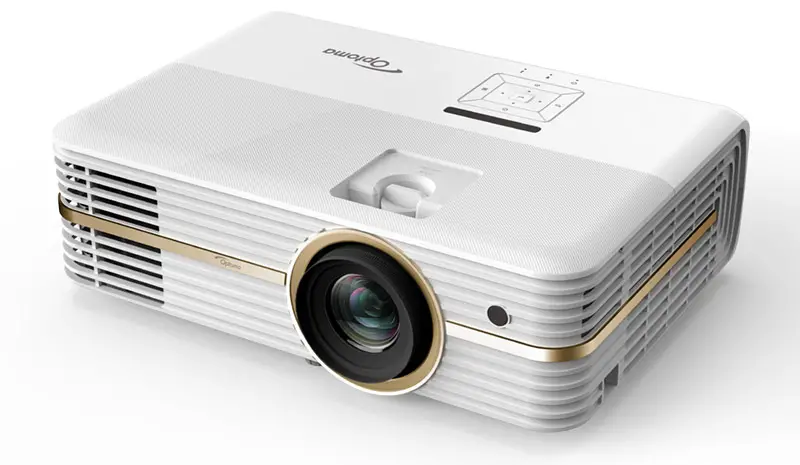
The UHD51A also comes with a build in media player that you can use to stream content through the USB port. We tried different types of content from SD, 1080p and 4K with HDR and everything seemed to play smoothly and without any problems.And if you have enabled Alexa with the projector you can use it to issue basic playback commands during viewing.
Lastly we measured input lag and here we were left a bit disappointed. Of course our readings were changing depending color mode, but more or less we got around 65ms which is a bit on the high side and although for movies it is just fine some serious gamers may find it unacceptable.
Final Thoughts
There is a lot to like in the Optoma UHD51A. Before you take any of it’s specs into consideration you have to keep in mind that we are talking about a sub $2,000 projector and as such it should be judged. Optoma really tried to create a feature complete projector at the lowest price possible and for that matter it is our belief that they succeeded in doing so.
The Optoma UHD51A offers very good 4K image that is clean and very detailed, its HDR capabilities are good enough for a projector in this category, it is 3D capable and it has very good overall motion performance. As for connectivity it offers a great variety of ports that surpasses most of the competition. And in all this we should not forget the wealth of features it is equipped with like the built-in media player for example among others in addition to being one of the first projectors that is smart enabled by adding support for Amazon Alexa and Google Assistant.
On the opposite side being a low priced 4K projector means that a few things would naturally not be so good. Black levels in general are so and so and although for many people will be more than enough for image quality fans it will be very obvious. Of course in this price we haven’t seen any 4K projector offering very deep blacks so this is not a problem of the Optoma specifically but seems to be the general standard for this price range. Also brightness although was adequate it measured far less than what Optoma claimed it to be. Input lag was also measured very high making it difficult to suggest this projector for serious online gaming. Lastly we would definitely like a better remote that would have backlight function and this is a feature that should be a given in this day and age.
Closing we can say that we liked what we saw with the UHD51A as it offered so many things in such a low price that for most people that want to create a home cinema but don’t want to spend a fortune for equipment the Optoma is exactly what they need. Performance is good, features are plenty and price is just about right in order to create a very good option to consider and one that we can definitely recommend.
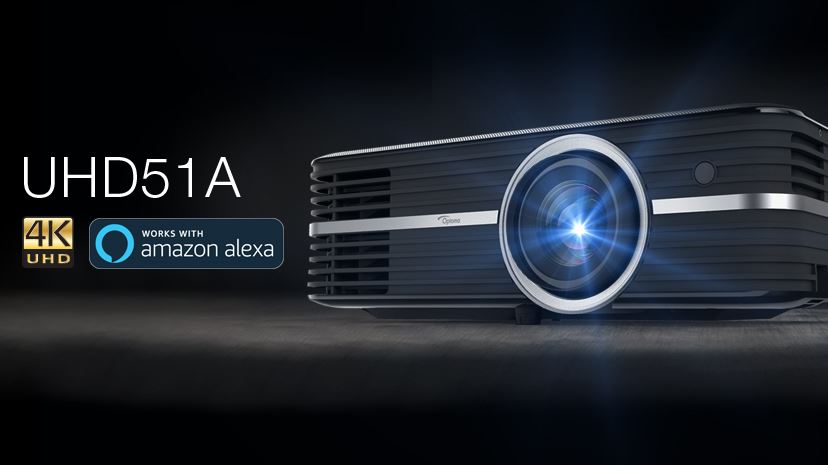
For more reviews you can check our dedicated 4K Projector reviews list or even look at our Product Reviews Table where you can find the brand and specific product you are looking for.
Cheapest Places to Buy :
*We are a reader-supported website. When you buy through links on our site, we may earn a small affiliate commission at no extra cost to you. Home Media Entertainment does not accept money for reviews.*
Specifications
- Aspect Ratio : 16:9 (native), 4:3 and LBX compatible
- Audio : 2x 5 Watt Speakers
- Brightness : 2,400 ANSI lumens
- Color Wheel : RGBRGB 6 segment color wheel
- Connections : 2xHDMI 2.0 (w/ HDCP 2.2, MHL 2.1), VGA-in, audio-in (3.5mm), audio-out, S/PDIF out (optical), x4 USB 2.0, RJ-45, RS-232C, 12V trigger
- Contrast Ratio : Up to 500,000:1 with Dynamic Black
- Display Technology : Single 0.47” 4K UHD DMD DLP® by Texas Instruments™
- Image Size : 34.1” – 302.4 (34.1” to 140” optimal image size)
- Light Source Life : 4,000/10,000/15,000 (Bright/ECO/Dynamic)
- Lens Shift : Vertical: 15% offset (with tolerance ±5%)
- Maximum Resolution : 4K (4096 x 2160) @ 30Hz
- Native Resolution : 4K UHD (3840 x 2160) @ 60Hz with XPR Technology
- Noise Level : 28/25dB (Bright/ECO)
- Offset : 100% (see Lens Shift)
- Operating Temperature : 41–104°F (5–40°C), 85% max humidity
- Power Consumption : 317W typical (Bright mode), 348W max (Bright mode), 259W typical (Eco+ mode), 285W max (Eco+ mode)
- Power Supply : AC input 100–240V, 50–60Hz, auto-switching
- Projection Distance : 2.9’ – 34.89’
- Projection Lens : F=2.5 – 3.26, F=20.91 – 32.62 mm manual focus
- Projection Method : Front, rear, ceiling mount, table top
- Remote Control : Full Function Home Remote Control
- Throw Ratio : 1.21 – 1.59 (distance/width) ±5% variance
- Uniformity : 80%
- Zoom Type : 1.3x Manual, 0.8 – 2.0 Digital
- 3D Compatibility : Side-by-Side: 1080i50 / 60, 720p50 / 60, Frame-pack: 1080p24, 720p50 / 60, Over-Under: 1080p24, 720p50 / 60
- Computer Compatibility : 4K UHD 2160p, WUXGA, HDTV 1080p, UXGA, SXGA, WXGA+, WXGA (1366×768), WXGA, HDTV (720p), XGA, SVGA, VGA, PC and Mac compatible
- Video Compatibility : 4K UHD 2160p (24/50/60Hz), 1080p (24/50/60Hz), 1080i (50/60Hz), 720p (50/60Hz), 480i/p, 576i/p
- Security : Kensington® lock port, password (OSD)
- Dimensions : 15.4” x 11.1” x 5.1” / 392 mm x 281 mm x 118 mm
- Weight : 11.75 lbs / 5.22kg

I found this to be a very thorough review and I appreciate your honesty in sharing both pros and cons on the Optoma Projector. I especially like that you mention heat dissipation and how this projector attempts to solve that problem. It is one of the issues I have dealt with on projectors in the past. Also, the quietness of the fan is attractive so that it doesn’t affect quality of other sounds you might actually want to hear when using it. Thanks for an overall great review!
I hope you found our review useful Tucker. Come back for more reviews soon!
Optoma UHD51A is the perfect projector. You gave us so much information to where I don’t know where to start once I purchase the Optoma UHD51A. Technology has advanced so much in today’s life to where this is going to be a good buy. I really appreciate the way you took your time and layed out this beautiful post.
I really want to thank you for this very informative article.
Thank you Qyinn. We always try to provide in-depth and useful reviews for our readers.
Hey Strato,
I never thought of buying a UHD home cinema projector. I thought that this equipment would be more appropriate for larger places such as cafes, pubs or sports bars – unless one has a dedicated cinema room. I’d love to have one someday 🙂
Is this one of the best in the market? Is it a value for money purchase?
Thanks for a very detailed review.
Marios
Hello Marios. You cannot say one of the best as there are projectors with 5 or 10 times the price of the optoma with better hardware and optics but for this price range we would rate the Optoma one of the best. And yes for the price you pay for it, it is worth it.
My best friend is looking for a really good projector and your review of the Optoma UHD51A 4K DLP Projector is perfect. The design of it doesn’t look horrible, but not great either. It kind of reminds me of the early Xbox as far as looks. It’s good to know that it has good heat dissipation that helps with the internal fan. It’s interesting to know that the black levels aren’t that great, but it at least has a good amount of connections to it. My friend will also like the fact that this projector supports HDR. I will definitely share this review with him, thank you for posting this. Do you have this particular 4K projector or do you prefer another one?
The projectors in our articles are just for review purposes, I personally prefer a TV but I can understand why many people prefer projectors. It is entirely a personal preference and doesn’t have to do with the capabilities of the projectors.
Hi how are you? This post is perfect for me, I just moved with my husband in our first house, and we love watching the movies, we are creating our home theater, I think this projector is the ideal for us, as you say, has problems with the scale of Blacks but the price is pretty good considering all the other positives.
And I love that it comes incorporated with Alexa and also its operating system is Android.Thank you very much for this very complete review!Pao
You are welcome Paola. I hope our review will help you decide.
I found this review to be very easy to read and useful.
It is great to see that you are now able to purchase a 4k projector for less than $2000.00. When these projectors first came on the market I remember them costing more than 20k. These weren’t even smart enabled like this UHD51A.
I was curious to what the next step up would be if you wanted to have the same features as this projector but with deeper black levels. Also capable of providing a good gaming experience?
Going to take a look at some of your A/V receiver reviews. Really like how easy to read your reviews are.
The same exact features with better blacks will be a bit hard to find as the UHD51A was the first to incorporate Alexa and Google Home support. Projectors with better blacks than the Optoma you can find and the one closer in price is the LG HU80KA from the ones we have tested. The price is almost double of the Optoma but at the price of the UHD51A it will be hard to find a projector with much difference in black levels so you will have to go higher in price to see some obvious difference.
You mentioned a generic Wi-Fi Dongle would this work with Roku than also if you dont have say amazon firestick? I would consider something like this for the 3d cabapilities. How is the picture quality on the 3d ? I like the size and price of the Optuma uhd51a with the holidays coming up I will have to do a bit more research. Thank you for the information very good review.
The generic Wi-Fi dongle is for having wireless connection to the internet. As for 3D it’s performance as we analyzed above is very good and we were pleased with what we saw. It’s a worthy purchase if you consider buying it.
I like the look and design of it, even if it is relatively cheap plastic.
This is a great buy for someone who just wants the basic projector for a decent price.
It looked awesome in the video, with the ability to use Amazom Alexa and project great quality pictures.
The Optoma really offers almost everything at a very good price. It may not offer the best image quality possible in projectors but for that you will have to go extremely high in price. If you put everything together then it is definitely a worthy purchase by far.